The subtleties of overseas sales. How to design and zone shoe stores in New York during the period of big discounts.

“Girls come to New York in search of two“ Ls ”- Labels and Love,“ once said Carrie Bradshaw, the heroine of the famous series “Sex and the City”, which showed the fashionable (and not only) life of New York to the whole world . We don’t know how it is with the simplicity of finding love in this big city, but finding world labels is no problem, and with a very good discount. Before the holidays ended, New York stores began to actively lure customers with discounts, gifts and other attractive offers. Read about the intricacies and tricks of organizing, designing and conducting after-sale sales in New York in an exclusive report by our permanent expert and author Kristina Wojciechowska. The finds and ideas of American colleagues are commented and evaluated by Anna Balandina, an expert on visual merchandising, showcase and store design.
 Kristina Morozova (Wojciechowska) - Certified business coach, Fashion retail expert, general manager of KEDDO in America (New York, USA).
Kristina Morozova (Wojciechowska) - Certified business coach, Fashion retail expert, general manager of KEDDO in America (New York, USA). Anna Balandina -
Anna Balandina - owner of visual communications agency VM Guru, market expert in visual merchandising and store design.
@anna_balandina_vmguru, @vm_guru, www.vmguru.ru
Sales in the Big Apple are commonplace, shops all year round offer discounted products, not only with those indicated on the price tags, but also with additional ones that can be obtained simply by “bargaining” with the seller. In addition, many stores issue bonus cards for residents of the city in addition to discount ones (if certain documents are available, otherwise nothing). Cards allow you to significantly save money, but oblige you to use them only for a certain period of time (usually 1,5-3 months).
Tourists are also not disregarded - they have their own bonuses and discounts. In addition, you can agree with the seller on an additional price reduction (by 10-15%), and for true shopaholics, special shop tours are organized around New York stores. The guide will guide you through the best shops, point out great deals, and act as a stylist, giving you valuable advice when choosing clothes and shoes.
The New York Winter Sale officially kicks off on December 20, just before Christmas. But until 25 (before Christmas) stores keep prices, discounts do not exceed 50%, but after January 2, when customers are getting fewer and work days begin, prices usually drop even lower.
Zoning, store design
Walking around Manhattan, I had to go around a lot of big and small stores to find interesting solutions for organizing sales in the fashion retail of New York.
The first thing that catches your eye is the very neat design of the sales areas. No huge posters, flashy fonts and huge, tasteless posters. Everything is strict and restrained.
The main colors of sales are the same as in Russia: red and white, sometimes stores use blue and black and white. But there will never be more than two colors in an informational poster.
Anna Balandina: “Sale is a marketing tool, the main requirement for POS registration of a sale period is that it is read, moreover, correctly read by customers, and that they go into the store. It was tested by American neuromarketing experts that buyers shop window information on a sale subconsciously as follows: the larger and brighter the message, the more subconsciously it is better perceived. The buyer reads it like this: "The store has good discounts, you have to go." At the same time, in the initial sales period (in New York, judging by the article, this is from December 20 to January 2), sales are not really “aggressively” displayed in store windows, because discounts are not so serious, and there is a problem to sell seasonal goods at full cost. Further, in the active phase of the sale, brands usually strengthen the sales message. There are several ways, the most effective are large stickers on the window with aggressive fonts, indicating the maximum percentage of discounts, in combination with a trading room decorated in the same style. And so that the design does not become “market", it is better to really use no more than two colors, and precisely those that the author speaks of. "
In New York stores there is an interesting feature in merchandising - sales are somehow allocated separately mainly only in two areas of the store: in the entrance, which serves to attract the attention of visitors and passers-by, and in the most remote place, somewhere in the corner, where tightly and deliberately scruffy shoes are distributed by size and stand out with separate advertising materials that alert customers that this is where the discounts are collected (scary to think!) up to 90% for all well-known brands. A familiar story, but it works.
On average, discounts in a special discount zone are 50%, but due to the artificially created deficit, visitors are in a hurry to find a suitable model and run with it to the cashier with a view, as if they had torn off something especially valuable. Layout in such cases on tall racks in size (sometimes full pairs, sometimes half pairs). This is very convenient: you don’t have to wait for a consultant with your size, you just find the “39” sign (in America - “9”) and choose from everything that is available. Add bright price tags that employees, without ceremony, glue directly to the sole or insole with the old crossed out price, inciting, nagging sellers, who seem to accidentally discuss right above your ear that models of my size are flying away like hot cakes today and - voila, a long line of customers at the checkout.
I can’t say that in these zones there are really very low prices - yes, below average, but these are mainly old collections or very unpopular models. However, the simplicity of the calculations attractive to customers, the availability of different models for searching and fitting, the lack of persistent (and sometimes annoyingly unpleasant) attention of sellers forces them to stay in the store for a long time and remeasure everything that, even in theory, could do. And in the end, buy, buy even that which I had not planned at all and about which I did not even think!
All this is a separate layout of the “sale”, as already mentioned, in the most impassable, “dead” part of the store, in the back of the trading floor (people who come to buy something at a discount will find it anyway). The remaining discounts are not grouped in certain zones, they are dispersed throughout the hall and mixed with models that are sold without discounts.
Anna Balandina: “That's right. In the active phase of sales, it is important to place the sale offer primarily in the entrance area, and the buyer should be greeted by the zone with the maximum discount percentage and, preferably, inform the buyer about it with POS materials with the maximum discount percentage. Because buyers "go for discounts."
Why are shoes with a 90% discount displayed in a remote area of the trading floor? Most likely, these are shoes not even of the last, but strongly of the past seasons, and for the high (emphasis on "o") their cost cannot be sold. Although in America they are really trying to get rid of the product of the used season as much as possible during the next sale. In Russia, you will hardly find a 90% discount ”.
Shoe laying
The main ways of laying out shoes:
- by size (if it is a sale);
- by brand;
- by style;
- by groups.
Often, in one store you can find several display styles at once. If we go back to the price tags, then, as a rule, this is a sticky, bright price tag that is glued to shoes (on the sole or insole), shoe tags are used mainly for production information only. They try to make prices understandable and memorable, most often these are 3-4-5 prices in one group. For example, $ 49, $ 99.99, $ 25. The buyer is easy to remember and easy to navigate.
In general, I noticed an interesting feature: if in Russia we try to make a stylish and expensive repair and a really beautiful layout, then in New York, mid-range stores do not attach any importance to this. Clean and welcoming - yes, style - no. Very often boxes with shoes from the sale group (even with 20-30% discounts) are laid out on the table or directly on the floor with mountain materials, POS materials mark the location where the discounts are collected - and people run to catch luck by the tail - look for their size.
Where is the "junction"
Related products (shoe care products, socks, wallets, wallets, etc.) are located, as in Russia, mainly at the cash register, but, in addition, they can also be used on the trading floor when forming groups of goods for their functional purpose or style, fashion (for example, expensive shoes + care products, ankle boots and high warm knee-highs of a suitable color). I have never met the calculation of funds for the care of the cash register or in other hard-to-reach places. On the contrary, the goods are often duplicated and displayed on special trading equipment, at the level of an outstretched hand and the gaze of customers. Add to this the bright price tags directly pasted on the product, the lack of abundance of such a product and the light but well-thought-out chaos ... and related products (like chewing gum at the checkout counter in grocery supermarkets) are dismantled like hot cakes. Trading equipment itself is usually on wheels, which allows sellers to easily move it to different areas of the store if necessary.
Anna Balandina: “In visual merchandising, this presentation method is called“ grouping the main product with the complementary one ”- it really increases the sales of the complementary product, especially if it is duplicated, that is, it is also presented at the checkout in the case of“ soputka ”(shoe care products), or in the accessory area - bags, scarves, gloves, etc. ”.
About fashion and trends
Surprisingly, New Yorkers take fashion very frivolously and do not recognize common ideals. Who is wearing what is in trend. Here you can find boots from the latest DG collection in the subway car, Converse sneakers on the homeless and stilettos on the guys. And no one cares about anyone, as if everything that you can think of is perfectly acceptable to put on yourself and walk in this form along the street, not at all thinking that you can shock, surprise, make someone laugh. Here it is not customary to condemn and poke a finger, everyone has the right to be what he wants, and this is captivating. And relaxes. In a huge metropolis there are almost no women in high-heeled shoes or wedges, the most popular shoes are sneakers and all-terrain boots. Perhaps that is why such a cool attitude to shoes, including well-known brands, can be found in shoe stores. These are just shoes, not an idol in a beautiful box.
In stores on the same shelf, No name sneakers for $ 15 and, say, Fendi or Manolo Blahnik with a crazy discount for $ 700 can coexist quite comfortably. Obviously, the stores here are also fighting for customers, but they do it with pretense of negligence, albeit retaining the famous American smile and aleatherg “How are you?” From every incoming visitor.
Anna Balandina: “New Yorkers are world trendsetters, creative people without complexes! Our compatriots as a whole are followers, and bold trends do not reach us quickly and not all take root ... But the fact that Noname sneakers are located on the "sale" next to expensive luxury brands is strange. Either this is a mistake of a visual merchandising specialist, or some clever strategy of this particular outlet. For example, a huge batch of these sneakers was purchased, and it was not sold at all during the season, or it is its own product. But this is definitely not an idea that needs to be adopted. "
This article was published in the 144 issue of the print version of the magazine.
| Please rate the article |
Materials on the topic
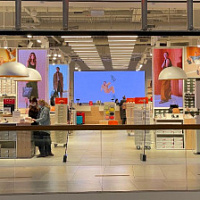
Should a shoe store spend money on digital screens?
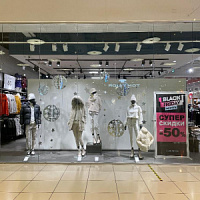
Mistakes in the lighting of the sales area that spoil the impression of a shoe store
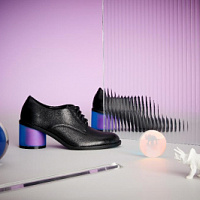
Technical aspects of display space and current trends in its design
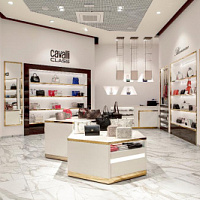
Design rules for a shoe and accessories store
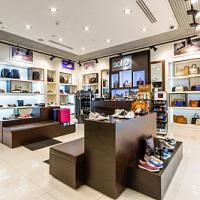
Pandemic-influenced visual merchandising transformation for shoe and accessories store
Popular
 Coach turned to Big Data analysis and won the interest of a young audience
American handbag brand Coach has planned the success of its Tabby model among a younger audience, Generation Z, by turning to big data analysis, abandoning traditional and analogue tools, such as human intuition or the ability of any executive to sense “which way the wind will blow,” writes B.O.F.
Coach turned to Big Data analysis and won the interest of a young audience
American handbag brand Coach has planned the success of its Tabby model among a younger audience, Generation Z, by turning to big data analysis, abandoning traditional and analogue tools, such as human intuition or the ability of any executive to sense “which way the wind will blow,” writes B.O.F.
 IDOL updates the concept
The IDOL brand, part of the Melon Fashion Group portfolio, opened the first flagship in an updated concept in the Aviapark shopping center in Moscow.
IDOL updates the concept
The IDOL brand, part of the Melon Fashion Group portfolio, opened the first flagship in an updated concept in the Aviapark shopping center in Moscow.
 Seven “sins” of the shoe business. How do owners harm the company with their own hands?
Why is Company X able to create a strong, profitable brand, but Company Y is struggling to make ends meet? Many people prefer to attribute success to luck, luck, or the support of strong patrons. And few people ask themselves the question: “What am I doing wrong?” Moreover, many entrepreneurs begin to harm their business from the first day of its opening. In this article, together with SR expert in the field of fashion business management and development, Maria Gerasimenko, we will look at the 7 main “sins” that business owners commit using specific examples.
Seven “sins” of the shoe business. How do owners harm the company with their own hands?
Why is Company X able to create a strong, profitable brand, but Company Y is struggling to make ends meet? Many people prefer to attribute success to luck, luck, or the support of strong patrons. And few people ask themselves the question: “What am I doing wrong?” Moreover, many entrepreneurs begin to harm their business from the first day of its opening. In this article, together with SR expert in the field of fashion business management and development, Maria Gerasimenko, we will look at the 7 main “sins” that business owners commit using specific examples.
 Louis Vuitton opens a new factory in Italy
Louis Vuitton has opened its second shoe factory in Italy. After opening the first one in Fiesso d'Artico in Veneto, the LVMH flagship brand has just opened a new production site dedicated to this category of footwear in the industrial zone of Civitano in the Marche region. There is also another brand production facility in Tuscany, where bags and leather accessories are produced, writes fr.fashionnetwork.com.
Louis Vuitton opens a new factory in Italy
Louis Vuitton has opened its second shoe factory in Italy. After opening the first one in Fiesso d'Artico in Veneto, the LVMH flagship brand has just opened a new production site dedicated to this category of footwear in the industrial zone of Civitano in the Marche region. There is also another brand production facility in Tuscany, where bags and leather accessories are produced, writes fr.fashionnetwork.com.
 The Euro Shoes@CAF exhibition will be held in Almaty
From March 11 to 13, the Euro Shoes@CAF (Central Asia Fashion) exhibition will be held in Almaty at the Atakent exhibition complex. The exhibition, which is the largest international event in the fashion industry in Central Asia, will present collections of clothing, shoes and accessories.
The Euro Shoes@CAF exhibition will be held in Almaty
From March 11 to 13, the Euro Shoes@CAF (Central Asia Fashion) exhibition will be held in Almaty at the Atakent exhibition complex. The exhibition, which is the largest international event in the fashion industry in Central Asia, will present collections of clothing, shoes and accessories.
 Euro Shoes will start operating on February 19 in Moscow!
The winter session of the international exhibition of footwear and accessories Euro Shoes premiere collection will be held in Moscow at the Expocenter from February 19 to 22. The organizers promise the presence of all the main participants at the exhibition, as well as new names from Europe, Asia and Russia.
Euro Shoes will start operating on February 19 in Moscow!
The winter session of the international exhibition of footwear and accessories Euro Shoes premiere collection will be held in Moscow at the Expocenter from February 19 to 22. The organizers promise the presence of all the main participants at the exhibition, as well as new names from Europe, Asia and Russia.
 American buyers couldn't buy Birkin bags and sued Hermès
French fashion house Hermès is facing a lawsuit in California from two customers who were unable to purchase exclusive Birkin bags. The fashion house is accused of unfair commercial practices.
American buyers couldn't buy Birkin bags and sued Hermès
French fashion house Hermès is facing a lawsuit in California from two customers who were unable to purchase exclusive Birkin bags. The fashion house is accused of unfair commercial practices.
 Why Rendez-Vous and Yandex Lavka released a “bread bag”
Shoe retailer Rendez-Vous announced the launch of a spring collaboration with Yandex Lavka and released a roll that resembles the shape of a woman’s handbag. This “Bread Bag” is presented in the Yandex.Lavka application at a price of 249 rubles. On the product packaging there is a promotional code for 1000 rubles, which can be spent in the Rendez-Vous network.
Why Rendez-Vous and Yandex Lavka released a “bread bag”
Shoe retailer Rendez-Vous announced the launch of a spring collaboration with Yandex Lavka and released a roll that resembles the shape of a woman’s handbag. This “Bread Bag” is presented in the Yandex.Lavka application at a price of 249 rubles. On the product packaging there is a promotional code for 1000 rubles, which can be spent in the Rendez-Vous network.
 Camper has released innovative sneakers - designers
Spanish brand Camper's new Roku sneaker features six interchangeable components to create up to 64 different looks and color combinations. Roku means "six" in Japanese.
Camper has released innovative sneakers - designers
Spanish brand Camper's new Roku sneaker features six interchangeable components to create up to 64 different looks and color combinations. Roku means "six" in Japanese.
 Christian Louboutin presented a collection in a cowboy style
At the Loubi Show in Paris, the French luxury brand Christian Louboutin presented its fall 2024 collection, following the trend - in the style of the Wild West. It included cowboy boots and rhinestone loafers.
Christian Louboutin presented a collection in a cowboy style
At the Loubi Show in Paris, the French luxury brand Christian Louboutin presented its fall 2024 collection, following the trend - in the style of the Wild West. It included cowboy boots and rhinestone loafers.
 Fashion Week takes place in Moscow
Fashion Week takes place in the Russian capital. Events include fashion shows, markets where you can purchase clothes, bags and accessories, and a B2B Showroom for fashion industry professionals.
Fashion Week takes place in Moscow
Fashion Week takes place in the Russian capital. Events include fashion shows, markets where you can purchase clothes, bags and accessories, and a B2B Showroom for fashion industry professionals.
 Turkish brand Vaneda on Euro Shoes
Street style, sport, outdoor, military – the main style directions of footwear of the company from Turkey
Turkish brand Vaneda on Euro Shoes
Street style, sport, outdoor, military – the main style directions of footwear of the company from Turkey
 Kari accuses Zenden of unfair competition and is suing the FAS
The largest Russian shoe chain, Kari, appealed to the Moscow Arbitration Court to declare the actions of the Federal Antimonopoly Service (FAS) illegal, writes RBC.
Kari accuses Zenden of unfair competition and is suing the FAS
The largest Russian shoe chain, Kari, appealed to the Moscow Arbitration Court to declare the actions of the Federal Antimonopoly Service (FAS) illegal, writes RBC.
 Fashion trends Fall-Winter 2023/24 for commercial footwear purchases
Permanent contributor to Shoes Report. Elena Vinogradova, an expert in sales and purchases in the fashion business, prepared an overview of the trends for the autumn-winter 2023/24 season especially for us.
Fashion trends Fall-Winter 2023/24 for commercial footwear purchases
Permanent contributor to Shoes Report. Elena Vinogradova, an expert in sales and purchases in the fashion business, prepared an overview of the trends for the autumn-winter 2023/24 season especially for us.
 MSCHF and Crocs launch "Big Yellow Boots"
Creator of the Big Red Boots, Brooklyn brand MSCHF has teamed up with American plastic clog and sandal brand Crocs for another oversized shoe. The new Big Yellow Boots will go on sale on August 9th.
MSCHF and Crocs launch "Big Yellow Boots"
Creator of the Big Red Boots, Brooklyn brand MSCHF has teamed up with American plastic clog and sandal brand Crocs for another oversized shoe. The new Big Yellow Boots will go on sale on August 9th.
 Five rules of professional lighting for a shoe store - something that is relevant in any season
When developing a lighting concept for shoe retailers, it is important to take into account not only the history of the brand, the architectural content of the premises, the target audience of the stores, but also the seasonality of the goods. With the onset of the cold season, client preferences change: bright weightless shoes are replaced by more massive models in discreet dark colors. Despite significant differences in summer and winter collections, the overall philosophy of the brand, its recognition should remain unchanged at any time of the year. Tatyana Ryzhova, an SR lighting expert in fashion retail, has identified five basic rules for a competent lighting concept for a shoe store for readers of the magazine, which will help to present winter assortment to customers in a winning way.
Five rules of professional lighting for a shoe store - something that is relevant in any season
When developing a lighting concept for shoe retailers, it is important to take into account not only the history of the brand, the architectural content of the premises, the target audience of the stores, but also the seasonality of the goods. With the onset of the cold season, client preferences change: bright weightless shoes are replaced by more massive models in discreet dark colors. Despite significant differences in summer and winter collections, the overall philosophy of the brand, its recognition should remain unchanged at any time of the year. Tatyana Ryzhova, an SR lighting expert in fashion retail, has identified five basic rules for a competent lighting concept for a shoe store for readers of the magazine, which will help to present winter assortment to customers in a winning way.
 I doubt and object: how to find an approach to difficult clients?
How good and serene would be the work of a salesperson if the customers were calm, cheerful, always knew exactly what they wanted, and bought, bought, bought! It is a pity that this is possible only in dreams. Therefore, we will not dream, but we will act. Together with Maria Gerasimenko, a permanent author of SR, we understand the doubts and objections of buyers and build a strategy for working with them. Our expert pays special attention to the two main objections of buyers, on which 82% of sales are lost.
I doubt and object: how to find an approach to difficult clients?
How good and serene would be the work of a salesperson if the customers were calm, cheerful, always knew exactly what they wanted, and bought, bought, bought! It is a pity that this is possible only in dreams. Therefore, we will not dream, but we will act. Together with Maria Gerasimenko, a permanent author of SR, we understand the doubts and objections of buyers and build a strategy for working with them. Our expert pays special attention to the two main objections of buyers, on which 82% of sales are lost.
 EURO SHOES presents an updated section of the GLOBAL SHOES exhibition with collections of shoe and bag brands from Asian countries
EURO SHOES premiere collection is expanding. Along with the traditional pool of leading European footwear brands from Germany, Spain, Italy and Turkey, several dozen footwear and bag brands from the Middle Kingdom will be presented in the GLOBAL SHOES section at the Moscow Expocentre from August 29 to September 1.
EURO SHOES presents an updated section of the GLOBAL SHOES exhibition with collections of shoe and bag brands from Asian countries
EURO SHOES premiere collection is expanding. Along with the traditional pool of leading European footwear brands from Germany, Spain, Italy and Turkey, several dozen footwear and bag brands from the Middle Kingdom will be presented in the GLOBAL SHOES section at the Moscow Expocentre from August 29 to September 1.
 World Footwear Yearbook: Global footwear production reaches 23,9 billion pairs and is back to pre-pandemic levels
The Portuguese association of shoe manufacturers APICCAPS published the 13th edition of the international statistical bulletin World Footwear Yearbook for 2023, according to which in 2022 the production and export of shoes worldwide increased by 7,6% and 9%, respectively, and the world production of shoes reached 23,9 billion couples and returned to pre-pandemic levels.
World Footwear Yearbook: Global footwear production reaches 23,9 billion pairs and is back to pre-pandemic levels
The Portuguese association of shoe manufacturers APICCAPS published the 13th edition of the international statistical bulletin World Footwear Yearbook for 2023, according to which in 2022 the production and export of shoes worldwide increased by 7,6% and 9%, respectively, and the world production of shoes reached 23,9 billion couples and returned to pre-pandemic levels.
 Rostov footwear brand Novak presented a collection of sneakers and sneakers
In the spring-summer 2023 season, the Rostov-on-Don shoe brand Novak presented a cute collection of sneakers and sneakers for every day. The upper of the shoe is made of genuine leather, suede, nubuck, the sole is made of light EVA.
Rostov footwear brand Novak presented a collection of sneakers and sneakers
In the spring-summer 2023 season, the Rostov-on-Don shoe brand Novak presented a cute collection of sneakers and sneakers for every day. The upper of the shoe is made of genuine leather, suede, nubuck, the sole is made of light EVA.
 Jacquemus x Nike collaboration released
The second collaboration between Jacquemus and Nike, which has been talked about so much, is finally out. The appearance of the couple for many was a surprise. The model of Nike Air Force 1 sneakers, which was taken as the basis of the new collection, has undergone significant changes.
Jacquemus x Nike collaboration released
The second collaboration between Jacquemus and Nike, which has been talked about so much, is finally out. The appearance of the couple for many was a surprise. The model of Nike Air Force 1 sneakers, which was taken as the basis of the new collection, has undergone significant changes.
 Crocs releases a collaboration with Barbie
If Barbie ditched heels and wore crocs, they would be pink. It was this collection in pink that was released by the American brand of plastic clogs Crocs, for the release of the film "Barbie" in the United States.
Crocs releases a collaboration with Barbie
If Barbie ditched heels and wore crocs, they would be pink. It was this collection in pink that was released by the American brand of plastic clogs Crocs, for the release of the film "Barbie" in the United States.
 Japanese BAPE takes to the catwalk MSCHF Big Red Boots
The story of Brooklyn brand MSCHF's oversized rubber boots continues. The last time they made noise in the auditorium was at the Rick Owens menswear show. Now they have already appeared on the podium.
Japanese BAPE takes to the catwalk MSCHF Big Red Boots
The story of Brooklyn brand MSCHF's oversized rubber boots continues. The last time they made noise in the auditorium was at the Rick Owens menswear show. Now they have already appeared on the podium.
 Shoe educational program: what shoe soles are made of
“What is the difference between TEP and EVA? What does tunit promise me? Is PVC glue? What is the sole of these shoes made of? ”- the modern buyer wants to know everything. In order not to smash his face in front of him and be able to explain whether such a sole suits him in soles, carefully read this article. In it, process engineer Igor Okorokov tells what materials the soles of shoes are made of and what makes each of them so good.
Shoe educational program: what shoe soles are made of
“What is the difference between TEP and EVA? What does tunit promise me? Is PVC glue? What is the sole of these shoes made of? ”- the modern buyer wants to know everything. In order not to smash his face in front of him and be able to explain whether such a sole suits him in soles, carefully read this article. In it, process engineer Igor Okorokov tells what materials the soles of shoes are made of and what makes each of them so good.
 How to set prices that will earn
Some businessmen still confuse the concept of margin with the concept of trade margins and set prices for their goods, guided solely by the example of competitors. No wonder they go broke! Analyst at the Academy of Retail Technologies Maxim Gorshkov gives several tips and formulas with which you can set not only ruinous, but also profitable prices.
How to set prices that will earn
Some businessmen still confuse the concept of margin with the concept of trade margins and set prices for their goods, guided solely by the example of competitors. No wonder they go broke! Analyst at the Academy of Retail Technologies Maxim Gorshkov gives several tips and formulas with which you can set not only ruinous, but also profitable prices.
 Sales of shoes and accessories: effective techniques for business rhetoric
Which speech modules are effective in communicating with potential and current customers of shoe stores, and which are not, Anna Bocharova, a business consultant, knows.
Sales of shoes and accessories: effective techniques for business rhetoric
Which speech modules are effective in communicating with potential and current customers of shoe stores, and which are not, Anna Bocharova, a business consultant, knows.
 We form the salary of sellers: expert advice
“How do you charge your consultants for personal or general sales?” Is one of the most popular questions causing a lot of controversy and gossip on the online forums of retail business owners. Indeed, how to properly form the earnings of sellers? But what about bonuses, where to get a sales plan from, do employees allow them to buy goods at discounted stores? In search of truth, the Shoes Report turned to a dozen shoe retailers, but no company wanted to disclose its motivation system - the process of its development was too complicated and individual. Then we asked four business consultants, and finally became convinced that the topic of seller motivation is very complex, because even our experts could not come to a common opinion.
We form the salary of sellers: expert advice
“How do you charge your consultants for personal or general sales?” Is one of the most popular questions causing a lot of controversy and gossip on the online forums of retail business owners. Indeed, how to properly form the earnings of sellers? But what about bonuses, where to get a sales plan from, do employees allow them to buy goods at discounted stores? In search of truth, the Shoes Report turned to a dozen shoe retailers, but no company wanted to disclose its motivation system - the process of its development was too complicated and individual. Then we asked four business consultants, and finally became convinced that the topic of seller motivation is very complex, because even our experts could not come to a common opinion.
 Technology Selling Issues
There is nothing worse than meeting the buyer with the words “Hello, can I help you with something?”, Because the seller works in the store just to help. Criticizing this well-established pattern of communication with the buyer, Andrei Chirkarev, business coach for effective sales and the founder of the New Economy project, shares the technology of truly selling issues with readers of Shoes Report.
Technology Selling Issues
There is nothing worse than meeting the buyer with the words “Hello, can I help you with something?”, Because the seller works in the store just to help. Criticizing this well-established pattern of communication with the buyer, Andrei Chirkarev, business coach for effective sales and the founder of the New Economy project, shares the technology of truly selling issues with readers of Shoes Report.
 The whole truth about Bayer. Who is he and how to become one?
Bayer is no longer a new, but still a popular and sought-after profession. It’s fashionable to be a buyer. Buyers are at the origins of the emergence and development of trends. If the designer offers his vision of fashion in the season, then the buyer selects the most interesting commercial ideas. It is on buyers that the policy of sales of stores and what, in the end, the buyer will wear depends on. This profession is surrounded by a magical fleur, often associated with a lack of understanding of what exactly is the work of a buyer.
The whole truth about Bayer. Who is he and how to become one?
Bayer is no longer a new, but still a popular and sought-after profession. It’s fashionable to be a buyer. Buyers are at the origins of the emergence and development of trends. If the designer offers his vision of fashion in the season, then the buyer selects the most interesting commercial ideas. It is on buyers that the policy of sales of stores and what, in the end, the buyer will wear depends on. This profession is surrounded by a magical fleur, often associated with a lack of understanding of what exactly is the work of a buyer.
 Fur, and not only: types of lining
In the production of winter footwear, various materials are used that are designed to retain heat and meet the requirements of consumers: natural sheepleather, artificial fur, artificial fur from natural wool and others. All types of lining fur have their own advantages and disadvantages. Let's consider the properties of each of them.
Fur, and not only: types of lining
In the production of winter footwear, various materials are used that are designed to retain heat and meet the requirements of consumers: natural sheepleather, artificial fur, artificial fur from natural wool and others. All types of lining fur have their own advantages and disadvantages. Let's consider the properties of each of them.
 Retail Arithmetic
Before you begin to solve specific problems, you need to find out how accurately all the leaders of your company understand the basic terminology of retail.
Retail Arithmetic
Before you begin to solve specific problems, you need to find out how accurately all the leaders of your company understand the basic terminology of retail.
 How to fire a worker without tears, scandal and trial
Sooner or later, any manager is faced with the need to part with an employee. Properly and on time the dismissal procedure will save the company money, and the boss himself - nerves and time. But why sometimes, knowing that a break in relations is inevitable, we put off the decision for months?
How to fire a worker without tears, scandal and trial
Sooner or later, any manager is faced with the need to part with an employee. Properly and on time the dismissal procedure will save the company money, and the boss himself - nerves and time. But why sometimes, knowing that a break in relations is inevitable, we put off the decision for months?






